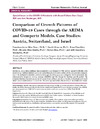Identificador persistente para citar o vincular este elemento:
https://accedacris.ulpgc.es/jspui/handle/10553/107471
| Campo DC | Valor | idioma |
|---|---|---|
| dc.contributor.author | Perez, Francisco Javier Diaz | en_US |
| dc.contributor.author | Chinarro, David | en_US |
| dc.contributor.author | Otin, Rosa Pino | en_US |
| dc.contributor.author | Martín, Ricardo Díaz | en_US |
| dc.contributor.author | Díaz Cabrera, Moisés | en_US |
| dc.contributor.author | Mouhaffel, Adib Guardiola | en_US |
| dc.date.accessioned | 2021-06-09T11:45:25Z | - |
| dc.date.available | 2021-06-09T11:45:25Z | - |
| dc.date.issued | 2020 | en_US |
| dc.identifier.issn | 2076-9172 | en_US |
| dc.identifier.uri | https://accedacris.ulpgc.es/handle/10553/107471 | - |
| dc.description.abstract | On May 19, 2020, data confirmed that coronavirus 2019 disease (COVID-19) had spread worldwide, with more than 4.7 million infected people and more than 316,000 deaths. In this article, we carry out a comparison of the methods to calculate and forecast the growth of the pandemic using two statistical models: the autoregressive integrated moving average (ARIMA) and the Gompertz function growth model. The countries that have been chosen to verify the usefulness of these models are Austria, Switzerland, and Israel, which have a similar number of habitants. The investigation to check the accuracy of the models was carried out using data on confirmed, non-asymptomatic cases and confirmed deaths from the period February 21-May 19, 2020. We use the root mean squared error (RMSE), the mean absolute percentage error (MAPE), and the regression coefficient index R2 to check the accuracy of the models. The experimental results provide promising adjustment errors for both models (R >0.99), with the ARIMA model being the best for infections and the Gompertz best for mortality. It has also been verified that countries are affected differently, which may be due to external factors that are difficult to measure quantitatively. These models provide a fast and effective system to check the growth of pandemics that can be useful for health systems and politicians so that appropriate measures are taken and countries' health care systems do not collapse. 2 | en_US |
| dc.language | eng | en_US |
| dc.relation.ispartof | Rambam Maimonides Medical Journal | en_US |
| dc.source | Rambam Maimonides Medical Journal [ISSN 2076-9172], v. 11 (3), eoo22. Special Issue on the COVID-19 Pandemic with Guest Editors Oren Caspi, M.D. and Ami Neuberger, M.D. | en_US |
| dc.subject.other | ARIMA | en_US |
| dc.subject.other | Coronavirus | en_US |
| dc.subject.other | COVID-19 | en_US |
| dc.subject.other | Gompertz | en_US |
| dc.subject.other | Growth model | en_US |
| dc.title | Comparison of growth patterns of COVID-19 cases through the arima and gompertz models. case studies: Austria, Switzerland, and Israel | en_US |
| dc.type | Article | en_US |
| dc.identifier.doi | 10.5041/RMMJ.10413 | en_US |
| dc.identifier.scopus | 2-s2.0-85096328005 | - |
| dc.contributor.orcid | #NODATA# | - |
| dc.contributor.orcid | #NODATA# | - |
| dc.contributor.orcid | #NODATA# | - |
| dc.contributor.orcid | #NODATA# | - |
| dc.contributor.orcid | #NODATA# | - |
| dc.contributor.orcid | #NODATA# | - |
| dc.identifier.issue | 3 | - |
| dc.relation.volume | 11 | en_US |
| dc.investigacion | Ciencias | en_US |
| dc.type2 | Artículo | en_US |
| dc.description.numberofpages | 13 | en_US |
| dc.utils.revision | Sí | en_US |
| dc.date.coverdate | Julio 2020 | en_US |
| dc.identifier.ulpgc | No | en_US |
| dc.contributor.buulpgc | BU-BAS | en_US |
| dc.description.sjr | 0,19 | |
| dc.description.sjrq | Q4 | |
| dc.description.esci | ESCI | |
| item.fulltext | Con texto completo | - |
| item.grantfulltext | open | - |
| crisitem.author.dept | GIR IDeTIC: División de Procesado Digital de Señales | - |
| crisitem.author.dept | IU para el Desarrollo Tecnológico y la Innovación | - |
| crisitem.author.dept | Departamento de Física | - |
| crisitem.author.orcid | 0000-0003-3878-3867 | - |
| crisitem.author.parentorg | IU para el Desarrollo Tecnológico y la Innovación | - |
| crisitem.author.fullName | Díaz Cabrera, Moisés | - |
| Colección: | Artículos | |
Citas SCOPUSTM
10
actualizado el 08-jun-2025
Citas de WEB OF SCIENCETM
Citations
12
actualizado el 08-jun-2025
Visitas
123
actualizado el 23-sep-2024
Descargas
62
actualizado el 23-sep-2024
Google ScholarTM
Verifica
Altmetric
Comparte
Exporta metadatos
Los elementos en ULPGC accedaCRIS están protegidos por derechos de autor con todos los derechos reservados, a menos que se indique lo contrario.
